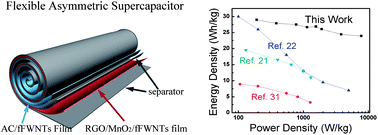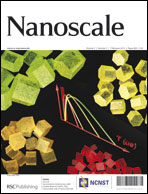Supercapacitors with both high energy and high power densities are critical for many practical applications. In this paper, we discuss the design and demonstrate the fabrication of flexible asymmetric supercapacitors based on nanocomposite electrodes of MnO2, activated carbon, carbon nanotubes and graphene. The combined unique properties of each of these components enable highly flexible and mechanically strong films that can serve as electrodes directly without using any current collectors or binders. Using these flexible electrodes and a roll-up approach, asymmetric supercapacitors with 2 V working voltage were successfully fabricated. The fabricated device showed excellent rate capability, with 78% of the original capacitance retained when the scan rate was increased from 2 mV s−1 to 500 mV s−1. Owing to the unique composite structure, these supercapacitors were able to deliver high energy density (24 W h kg−1) under high power density (7.8 kW kg−1) conditions. These features could enable supercapacitor based energy storage systems to be very attractive for a variety of critical applications, such as the power sources in hybrid electric vehicles and the back-up powers for wind and solar energy, where both high energy density and high power density are required.

You have access to this article
 Please wait while we load your content...
Something went wrong. Try again?
Please wait while we load your content...
Something went wrong. Try again?


 Please wait while we load your content...
Please wait while we load your content...